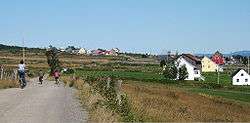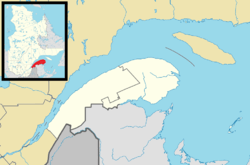Notre-Dame-des-Sept-Douleurs, Quebec
Notre-Dame-des-Sept-Douleurs (French, meaning "Our Lady of Seven Sorrows") is an island municipality in the Bas-Saint-Laurent region of Quebec, Canada, part of the Rivière-du-Loup Regional County Municipality. It is located on and contiguous with Île Verte (French for "Green Island") in the Saint Lawrence River, about 20 kilometres (12 mi) north-east of Rivière-du-Loup. The name Île Verte was given in 1621 by Samuel de Champlain written "Isle Verte".
Notre-Dame-des-Sept-Douleurs | |
|---|---|
Parish municipality | |
 | |
 Location within Rivière-du-Loup RCM | |
 Notre-Dame-des-Sept-Douleurs Location in eastern Quebec | |
| Coordinates: 48°00′N 69°27′W[1] | |
| Country | |
| Province | |
| Region | Bas-Saint-Laurent |
| RCM | Rivière-du-Loup |
| Constituted | January 1, 1874 |
| Government | |
| • Mayor | Gilbert Delage |
| • Federal riding | Montmagny—L'Islet—Kamouraska—Rivière-du-Loup |
| • Prov. riding | Rivière-du-Loup-Témiscouata |
| Area | |
| • Total | 141.80 km2 (54.75 sq mi) |
| • Land | 11.61 km2 (4.48 sq mi) |
| Population (2011)[3] | |
| • Total | 49 |
| • Density | 4.2/km2 (11/sq mi) |
| • Pop 2006-2011 | |
| • Dwellings | 104 |
| Time zone | UTC−5 (EST) |
| • Summer (DST) | UTC−4 (EDT) |
| Postal code(s) | G0L 1K0 |
| Area code(s) | 418 and 581 |
| Highways | No major routes |
| Website | www |
With a population of only 49 persons, Notre-Dame-des-Sept-Douleurs is one of the smallest municipalities in Canada.
The main economic activity is fishing and tourism. Many fish smokehouses are present on the island. The presence of the oldest lighthouse in Quebec (built in 1809), its pastoral character, skeleton museum, many artists and heritage homes also attracts tourism.[4]
History

The island was first mentioned in the Jesuit Reports of 1663 following a shipwreck which forced Henri Nouvel to stay there for about ten days.[4]
Some 200 years later in 1874, the municipality was formed out of the parish of La Décollation-de-Saint-Jean-Baptiste on November 18, which led to its name "Notre-Dame-des-Sept-Douleurs" since this date corresponded to the Day of Our Lady of Sorrows on the liturgical calendar at that time. However the municipality only existed on paper. The community formed in isolation and life on the island was governed by traditional customs, so people had little need for municipal management, which would have been a family affair anyway. Finally on February 5, 1912, the first council meeting took place.[4]
On 10 June 1816, half the Nova Scotia Fencibles, some 210 officers and other ranks, together with 48 wives and children, were on board the Archduke Charles when it wrecked near Green Island. Four soldiers, two wives, and two children lost their lives.
Today, the biggest family to occupy the Island is the Fraser of Scottish Canadian descent.
Demographics
Population trend:[5]
- Population in 2011: 49 (2006 to 2011 population change: -21.0%)
- Population in 2006: 62
- Population in 2001: 44
- Population in 1996: 42
- Population in 1991: 44
Private dwellings occupied by usual residents: 28 (total dwellings: 104)
Mother tongue:
- English as first language: 0%
- French as first language: 100%
- English and French as first language: 0%
- Other as first language: 0%
References
- Reference number 44874 of the Commission de toponymie du Québec (in French)
- Geographic code 12045 in the official Répertoire des municipalités (in French)
- Statistics Canada 2011 Census - Census Profiles: Notre-Dame-des-Sept-Douleurs
- "Notre-Dame-des-Sept-Douleurs (Municipalité de paroisse)" (in French). Commission de toponymie du Québec. Retrieved 2009-01-07.
- Statistics Canada: 1996, 2001, 2006, 2011 census
| Wikimedia Commons has media related to Notre-Dame-des-Sept-Douleurs. |